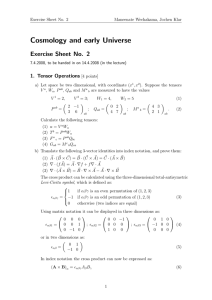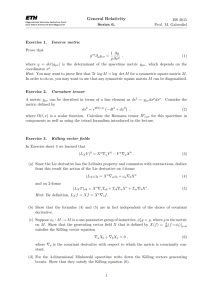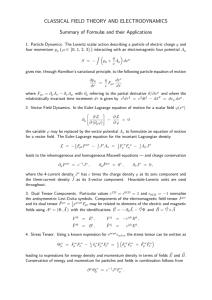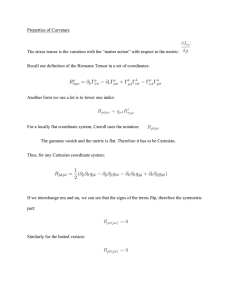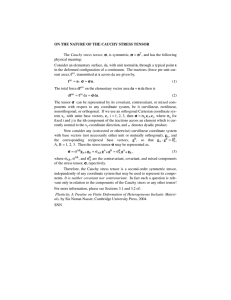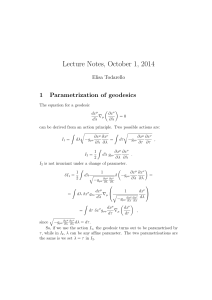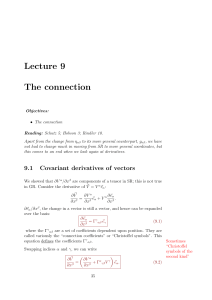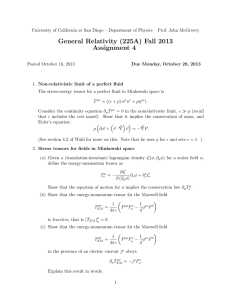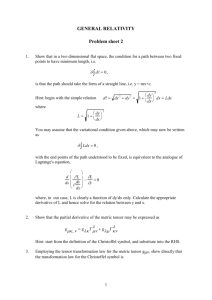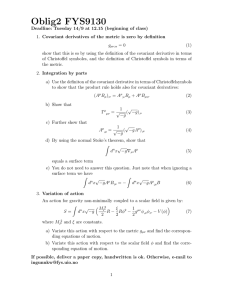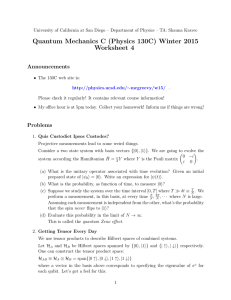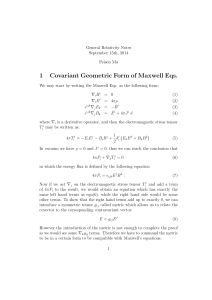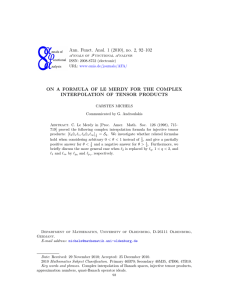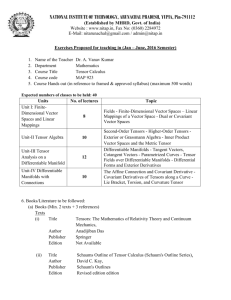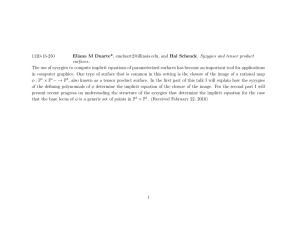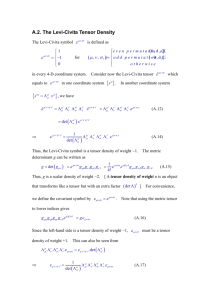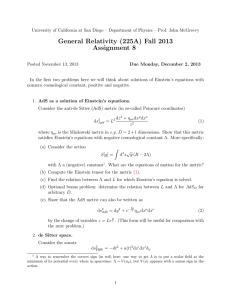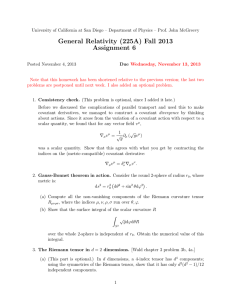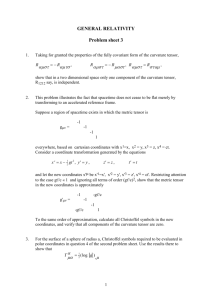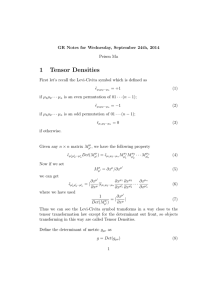Lecture Notes, September 30, 2014 1 Covariant Derivatives Elisa Todarello
advertisement
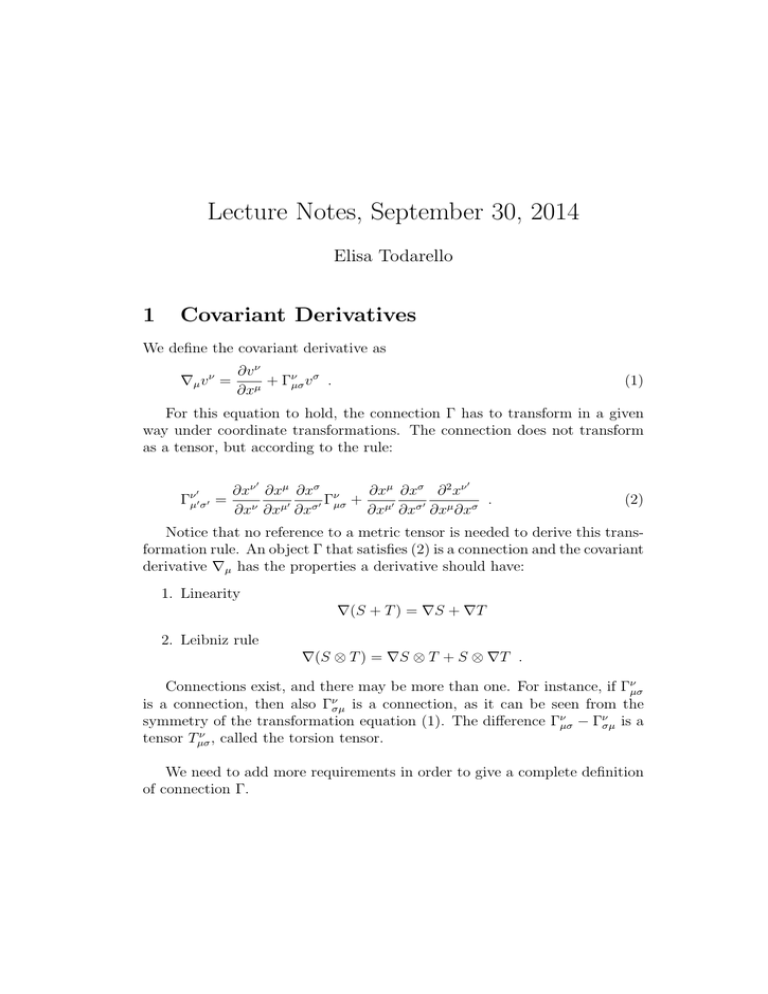
Lecture Notes, September 30, 2014 Elisa Todarello 1 Covariant Derivatives We define the covariant derivative as ∇µ v ν = ∂v ν + Γνµσ v σ . ∂xµ (1) For this equation to hold, the connection Γ has to transform in a given way under coordinate transformations. The connection does not transform as a tensor, but according to the rule: 0 0 Γνµ0 σ0 0 ∂xν ∂xµ ∂xσ ν ∂xµ ∂xσ ∂ 2 xν . = Γ + ∂xν ∂xµ0 ∂xσ0 µσ ∂xµ0 ∂xσ0 ∂xµ ∂xσ (2) Notice that no reference to a metric tensor is needed to derive this transformation rule. An object Γ that satisfies (2) is a connection and the covariant derivative ∇µ has the properties a derivative should have: 1. Linearity ∇(S + T ) = ∇S + ∇T 2. Leibniz rule ∇(S ⊗ T ) = ∇S ⊗ T + S ⊗ ∇T . Connections exist, and there may be more than one. For instance, if Γνµσ is a connection, then also Γνσµ is a connection, as it can be seen from the symmetry of the transformation equation (1). The difference Γνµσ − Γνσµ is a ν tensor Tµσ , called the torsion tensor. We need to add more requirements in order to give a complete definition of connection Γ. 3. Compatibility with ∇µ φ = ∂µ φ To check this, we need to create a scalar as φ = v µ ωµ 4. ∇µ commutes with index contraction Then we can write ? ∇µ φ = (∇µ v ν )ων + v ν (∇µ ων ) = (∂µ v ν )ων + v ν (∂µ ων ) . If this equation is true for any v ν , then we can say ∇µ ων = ∂µ ω ν − Γσµν ωσ . Assuming requirement (3) is satisfied, we can extend the result to a generic tensor ∇σ T µ1 µ2 ...µkν1 ν2 ...νl = ∂σ T µ1 µ2 ...µkν1 ν2 ...νl + Γµσλ1 T λµ2 ...µkν1 ν2 ...νl + Γµσλ2 T µ1 λ...µkν1 ν2 ...νl + . . . − Γλσν1 T µ1 µ2 ...µkλν2 ...νl − Γλσν2 T µ1 µ2 ...µkν1 λ...νl − . . . . If there are two connections, Γνµσ and Γ̃νµσ , then ν Sµσ = Γνµσ − Γ̃νµσ is a tensor. Adding two more conditions, we obtain the full definition of the metric compatible connection (which is unique). This connection is also called Christoffel symbol, or Riemann connection. 5. No torsion ν Tµσ =0 6. Relation with metric on a manifold (M, g) ∇µ g σν = 0 Hence, ∇λ µνρσ = 0 2 Parallel transport In flat space, if we want to compare two vectors (take the difference of the two), we can simply use the head-to-tail rule. This cannot be done in a curved space. We need to introduce the concept of parallel transport along a curve. We want to find some operator such that: D µ1 µ2 ...µk T ν1 ν2 ...νl = 0 . Dλ Define D dxµ ≡ ∇µ . Dλ dλ In fact, the equation for a geodesics is ν dxµ ∂x ∇µ =0 . dλ ∂λ For a vector v µ D µ v Dλ The factor dxν dλ = = = dxν ∇ν v µ dλν dx ∂v µ + Γµνσ vσ dλ ∂xν ν dv ν + Γµνσ dx vσ dλ dλ . depends on the curve along which we are transporting. We can write the above relation as a matrix equation (v µ )0 + M µσ v σ = 0 . This equation stresses the fact that (v µ )0 depends an all components of v µ .

